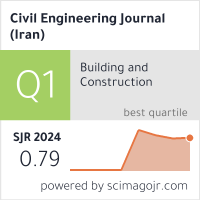A Consistency Check of Concrete Compressive Strength using Pearson's Correlation Coefficient
Downloads
The efficiency of the concrete ready mix service provider is undoubtedly and has become a widespread trend among contractors in which facilitates and eliminated a large budget surplus in maintenance, operating costs and is preferred as it reflects more efficient asset utilization. However, the quality assurance of concrete supplied is always raised associated with the inconsistencies of concrete compressive strength at the age of 28 days. The objective(s) of this study are to determine the correlations between the compressive strength of ready mix concrete, to evaluate the consistencies of the results and to identify the irregular sources that lead to the inconsistencies. Based on the compressive strength values obtained from the existing experimental data using different concrete mixes from the batching plant, a statistical analysis was conducted. A total of 90 concrete cubes specimens were attained from 15 concrete batches. A correlation analysis was conducted using the Pearson Correlation calculation to check the consistency of concrete compressive strength. The calculation showed the Pearson correlation coefficient of this study is +0.990. This indicated that there are significant linear relationship exists between the concrete compressive strength and the density of concrete batches which is positively high. In conclusion, the analysis reveals that the design of ready mix concrete compressive strength is in high consistencies and acceptable in practices for the proposed mix design to the contractor.
Doi:10.28991/cej-2021-03091672
Full Text:PDF
Downloads
[2] Alilou, Vahid K., and Mohammad Teshnehlab. "Prediction of 28-day compressive strength of concrete on the third day using artificial neural networks." International journal of Engineering 3, no. 6 (2010): 565-576.
[3] Abd elaty Metwally. "Compressive Strength Prediction of Portland Cement Concrete with Age Using a New Model.” HBRC Journal 10, no. 2 (August 2014): 145–155. doi:10.1016/j.hbrcj.2013.09.005.
[4] Price, Walter H. "Factors influencing concrete strength." American Concrete Institute 47, no. 2, (1951): 417-432.
[5] Raheem, Akeem Ayinde, Aliu Adebayo Soyingbe, and Amaka John Emenike. "Effect of curing methods on density and compressive strength of concrete." International Journal of Applied Science and Technology 3, no. 4 (2013): 55-64.
[6] Mamlouk, Michael S., and John P. Zaniewski. Materials for civil and construction engineers. Upper Saddle River, NJ: Pearson Prentice Hall, (2006).
[7] Nassif, Hani, and Nakin Suksawang. "Effect of Curing Methods on Durability of High-Performance Concrete.” Transportation Research Record: Journal of the Transportation Research Board 1798, no. 1 (January 2002): 31–38. doi:10.3141/1798-05.
[8] Ashish H. Makwana and Jayeshkumar P. "An approach for ready mixed concrete selection for construction companies through analytic hierarchy process.” International Journal of Engineering Trends and Technology (IJETT) 4, no. 7 (July 2013): 2878-2884.
[9] M. Vipin V. M. and Ashish P. W. "Compressive strength of ready mix concrete using soft computing techniques.” Int. Journal of Engineering Research and Applications 4, no. 12, Part 3 (December 2014): 12.
[10] R.S. Kale and S.Y. Kute. "Five layers artificial neural networks system [ANN] to design a concrete mix based on I.S.I method.” Current Advances in Civil Engineering, CACE 2, no. 4 (Oct. 2014): 118-125.
[11] Sudiono Daslim and Aqli Mursadin. "A control model for reinforced concrete work materials on the construction of Duta Mall 2.” Engineering, Technology & Applied Science Research 10, no. 2 (2020): 5483-5486. doi:10.5281/zenodo.3748356.
[12] BS 1377-2:1990. "Methods of test for soils for civil engineering purposes. Classification tests” (1991).
[13] BS1881:116. "Testing concrete part 116. Method for determination of compressive strength of concrete cubes.” London: British Standard Institution (1983).
[14] Waldir de Carvalho Junior, Maud Loireau, Mireille Fargette, Braz Calderano Filho, Abdoulaye Wele. "Correlation between soil erodibility and satellite data on areas of current desertification: a case study in Senegal.” Ci. & Tróp. Recife 41, no. 2, (2017): 51-66.
[15] Liang, Yongbo, Derek Abbott, Newton Howard, Kenneth Lim, Rabab Ward, and Mohamed Elgendi. "How Effective Is Pulse Arrival Time for Evaluating Blood Pressure? Challenges and Recommendations from a Study Using the MIMIC Database.” Journal of Clinical Medicine 8, no. 3 (March 11, 2019): 337. doi:10.3390/jcm8030337.
[16] Noguchi, Takafumi, and Fuminori Tomosawa. "Relationship between Compressive Strength and Modulus of Elasticity of High Strength Concrete.” Journal of Structural and Construction Engineering (Transactions of AIJ) 60, no. 474 (1995): 1–10. doi:10.3130/aijs.60.1_8.
[17] Mattacchione, Angelo, and Livia Mattacchione. "Correlation between 28-Day strength and density." Concrete International 17, no. 3 (1995): 37-41.
- Authors retain all copyrights. It is noticeable that authors will not be forced to sign any copyright transfer agreements.
- This work (including HTML and PDF Files) is licensed under a Creative Commons Attribution 4.0 International License.![]()















